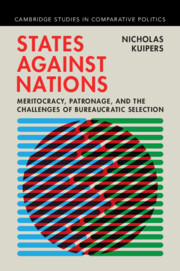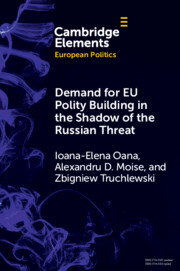Refine search
Actions for selected content:
97 results
1 - The United States and International State-Building Efforts
-
- Book:
- Hierarchy and the State
- Published online:
- 20 August 2025
- Print publication:
- 02 October 2025, pp 1-22
-
- Chapter
- Export citation
9 - Hierarchy and the State in a Multipolar World
-
- Book:
- Hierarchy and the State
- Published online:
- 20 August 2025
- Print publication:
- 02 October 2025, pp 191-202
-
- Chapter
- Export citation
9 - Law-Washing the Transitional State
-
-
- Book:
- Reckoning with Law in Excess
- Published online:
- 09 September 2025
- Print publication:
- 25 September 2025, pp 212-231
-
- Chapter
-
- You have access
- Open access
- HTML
- Export citation
Between Communal, Emphyteutic, and Private Property: Liberal Experimentation on Agricultural Land in Nineteenth-Century Bolivia
-
- Journal:
- The Americas , First View
- Published online by Cambridge University Press:
- 25 September 2025, pp. 1-24
-
- Article
-
- You have access
- Open access
- HTML
- Export citation

Democracy's Double Helix
- Participation, Equality and Revolution in Early Modern Europe
-
- Published online:
- 09 September 2025
- Print publication:
- 14 August 2025

States against Nations
- Meritocracy, Patronage, and the Challenges of Bureaucratic Selection
-
- Published online:
- 14 August 2025
- Print publication:
- 07 August 2025
1 - The legacy of the nomadic empires
-
-
- Book:
- The Cambridge History of War
- Published online:
- 18 July 2025
- Print publication:
- 14 August 2025, pp 53-70
-
- Chapter
- Export citation
1 - Medieval States and Estates
- from Part I - State-Building and Political Participation
-
- Book:
- Democracy's Double Helix
- Published online:
- 09 September 2025
- Print publication:
- 14 August 2025, pp 31-55
-
- Chapter
- Export citation
3 - Patterns and Mutations of Early Modern Participation
- from Part I - State-Building and Political Participation
-
- Book:
- Democracy's Double Helix
- Published online:
- 09 September 2025
- Print publication:
- 14 August 2025, pp 67-122
-
- Chapter
- Export citation
2 - Sixteenth-Century Origins of the Fiscal-Military State
- from Part I - State-Building and Political Participation
-
- Book:
- Democracy's Double Helix
- Published online:
- 09 September 2025
- Print publication:
- 14 August 2025, pp 56-66
-
- Chapter
- Export citation
7 - States, Subjects, Citizens
- from Part II - Notions and Practices of Equality
-
- Book:
- Democracy's Double Helix
- Published online:
- 09 September 2025
- Print publication:
- 14 August 2025, pp 161-170
-
- Chapter
- Export citation
2 - State-Building, Nation-Building, and a Theory of How Bureaucratic Selection Affects Both
-
- Book:
- States against Nations
- Published online:
- 14 August 2025
- Print publication:
- 07 August 2025, pp 32-74
-
- Chapter
- Export citation
Foreign faith and rising state: An examination of state-building dynamics in late 16th-century Japan
-
- Journal:
- Political Science Research and Methods , First View
- Published online by Cambridge University Press:
- 02 July 2025, pp. 1-20
-
- Article
-
- You have access
- Open access
- HTML
- Export citation

Demand for EU Polity Building in the Shadow of the Russian Threat
-
- Published online:
- 15 March 2025
- Print publication:
- 03 April 2025
-
- Element
-
- You have access
- Open access
- HTML
- Export citation
3 - A New Cycle of Protests
- from Part I - Context
-
- Book:
- The Making of Leaderful Mobilization
- Published online:
- 30 January 2025
- Print publication:
- 06 February 2025, pp 65-88
-
- Chapter
- Export citation
Incomplete Infrastructure: State-Building and the Early History of China’s Long-Distance Telephone Network, 1900–1937
-
- Journal:
- Transactions of the Royal Historical Society , First View
- Published online by Cambridge University Press:
- 03 February 2025, pp. 1-27
-
- Article
-
- You have access
- Open access
- HTML
- Export citation
4 - Crossing Borders
-
- Book:
- The Last Caravan
- Published online:
- 09 January 2025
- Print publication:
- 23 January 2025, pp 180-227
-
- Chapter
- Export citation
7 - Clash of the Titans
-
- Book:
- The Port
- Published online:
- 21 November 2024
- Print publication:
- 28 November 2024, pp 237-275
-
- Chapter
- Export citation
5 - State Building in the Polish Wild West
- from Part III - State Building in the Wake of Displacement
-
- Book:
- Uprooted
- Published online:
- 07 November 2024
- Print publication:
- 21 November 2024, pp 111-141
-
- Chapter
- Export citation
Chapter 29 - Post-conflict state-building
- from Part 4 - The new agenda: Globalisation and global challenges
-
-
- Book:
- An Introduction to International Relations
- Published online:
- 31 August 2024
- Print publication:
- 12 August 2024, pp 386-397
-
- Chapter
- Export citation
